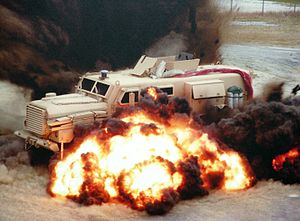Mine-Resistant Ambush Protected Vehicle


Mine-Resistant Ambush Protected Vehicle (MRAPV), also known as MRAP Vehicle, is a type of armoured personnel carrier that are designed specifically to withstand land mines, improvised explosive device (IED) attacks and ambushes to save troops' lives.[1][2][3][4] Most modern Infantry mobility vehicle also have certain level of MRAP capabilities.
History
[edit]This section needs to be updated. (December 2024) |
Specialized light armored vehicles designed specifically to resist land mines were first introduced in the 1970s by the Rhodesian Army, and were further developed by South African manufacturers starting in 1974 with the Hippo armored personnel carrier (APC).[5][6] The first step by the South African Defence Force (SADF) was the Bosvark, a Unimog fitted with a shallow mine-deflecting tub on the chassis to protect the crew. Then came the first generation of purpose-built vehicles, including the Hippo and various other light vehicles. They were essentially armoured V-shaped hulls mounted on truck chassis. The next generation was represented by the Buffel, a Unimog chassis with a mine-protected cab and a mine-protected crew compartment mounted on it. These early vehicles overloaded their chassis and they were clumsy off-road. The Casspir Mine-Resistant Ambush Protected Vehicle was developed for the SADF after 1980;[7] this was the inspiration for the American and other military MRAPV program and the basis for some of the program's vehicles.[8][9][10]
Design
[edit]
These vehicles have good off-road mobility, armour protection against small arms fire, improvised explosive device (IED) and anti-personnel mines. These armored vehicles generally have distinctive V-shaped hull (for mine protection) and a wheeled chassis.[1][2][3][4]
List of Mine-Resistant Ambush Protected Vehicles
[edit]Dedicated MRAPV
[edit]- ATF Dingo
- BAE Caiman – Part of the American MRAP program
- BMC Kirpi
- Cougar – Part of the American MRAP program
- CS/VP3 MRAP
- First Win
- Golan Armoured Vehicle
- International MaxxPro – Part of the American MRAP program
- Kalyani M4
- Kamaz Typhoon – Part of the Russian Typhoon program
- Mine Protected Combat Vehicle – Rhodesia IMV from 1979
- Nexter Aravis
- Force Protection Ocelot
- Oshkosh M-ATV – Part of the American MRAP program
- RG-31 Nyala
- RG-33 (6×6)
- Toofan – Iranian MRAP infantry mobility vehicle
- Unicob
- Zastava M20 MRAP
Infantry mobility vehicle with MRAP capabilities
[edit]- AMZ Żubr
- Bushmaster IMV
- COMBATGUARD
- Didgori series
- Grizzly APC
- Hunter TR-12
- Iveco LMV – Several thousand ordered by Italian military and other European militaries
- Kozak (armored personnel carrier)
- M16 Miloš
- Mahindra Armored Light Specialist Vehicle
- Mungo ESK
- Oshkosh L-ATV – Selected to meet US military's JLTV requirement on 25 August 2015
- Otokar Cobra
- Otokar Cobra II
- RG-33 (4×4)
- STREIT Group Spartan
- Varta
References
[edit]- ^ a b Pike, John. "Mine Resistant Ambush Protected (MRAP) Vehicle Program". www.globalsecurity.org. Retrieved 20 September 2018.
- ^ a b "Turkey Quietly Sent 50 Mine-Resistant Armored Vehicles to the Ukrainian Military". Autoevolution. 24 August 2022. Retrieved 30 November 2024.
- ^ a b "Rosoboronexport launches import-substituted Typhoon-K MRAP vehicle in foreign markets". Rosoboronexport. 23 April 2023. Retrieved 30 November 2024.
- ^ a b "Mine Resistant Ambush Protected (MRAP) Vehicle Vehicle Management Codes" (PDF). DEPARTMENT OF THE AIR FORCE.
- ^ "Lesakeng". South African Armour Museum. 2012-12-06. Archived from the original on 2013-07-03. Retrieved 2013-06-18.
- ^ Heitman, Helmoed-Römer. South African Armed Forces. Buffalo Publications 1990. ISBN 0-620-14878-0 p 44.
- ^ Russell, Robert W (2009). Does the MRAP meet the U.S. Army's needs as the primary method of protecting troops from the IED threat? (PDF) (Master of Military Art and Science thesis). US Army Command and General Staff College. Archived (PDF) from the original on October 9, 2012.
- ^ Mike Guardia (20 November 2013). US Army and Marine Corps MRAPs: Mine Resistant Ambush Protected Vehicles. Osprey Publishing. pp. 14–. ISBN 978-1-78096-255-9.
- ^ Leon Engelbrecht (8 February 2010). "Fact file: Casspir MRAP". Retrieved 5 November 2014.
- ^ "An MRAP for India". Retrieved 20 September 2018.
